
Cheese is an incredibly popular food, and when eaten in moderation it can make a nutritious addition to a wholesome well-balanced diet. However, with so many different varieties available it can be confusing for consumers to know what types of cheese are the best for their health. There are certain things you need to look out for when choosing a healthy good-quality cheese for you and your family.
Making cheese
Historically cheesemaking involves a fermentation technique that was used to prolong the life of fresh milk. The word cheese is derived from the Latin word “caseus” from an older word that means “to ferment”. Many cultures used different types of milk to make cheese, including goat, sheep, camel, yak, horse, buffalo and bison milk.
To make cheese, a starter culture of bacteria is first added to the milk which digests the lactose (milk sugars) and turns it into lactic acid. An enzyme called rennet is then added to curdle the milk. Rennet is found in the stomachs of young cows, sheep and goats. You can also find vegetarian alternatives now. The watery whey is then removed, leaving clumps of casein. Salt is added and the product is pressed into moulds and left to dry (or age) for varying amounts of time. The ageing process is a form of fermentation which can take weeks to years, depending on the type of cheese.
The nutritional content, taste and texture of a particular cheese is largely dependent on the type of milk and bacteria used, and how the cheese was produced.
Natural vs processed
This story is from the Issue #30, 2020 edition of Eat Well.
Start your 7-day Magzter GOLD free trial to access thousands of curated premium stories, and 8,500+ magazines and newspapers.
Already a subscriber ? Sign In
This story is from the Issue #30, 2020 edition of Eat Well.
Start your 7-day Magzter GOLD free trial to access thousands of curated premium stories, and 8,500+ magazines and newspapers.
Already a subscriber? Sign In
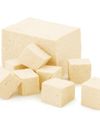
ARE YOU TO FU enough?
Love it or hate it, everyone has an opinion about tofu. Tofu is a very popular plant-based protein for vegans and vegetarians, but now this humble bean curd is starting to shine for meat lovers too as an alternative source of protein.

Sweet TRAYBAKES
Whether you want to feed a group of people or make a batch of treats for the week, traybaking is a no-fuss way to cook up something sweet and easy that will please everyone. Your family and friends will love you when you offer them some of our: cinnamon scrolls; fruity chocolate; espresso brownies; lemon & coconut slice; or ginger cake with brown butter frosting.

ROLL UP
When you roll food, whether in Lebanese bread, a thin pancake or whatever you choose, you can create a parcel of nutrition that is perfectly suited to your own tastes and needs. Here are some roll-up recipes that will suit every occasion including: mango, snow pea, & sprout rice paper rolls; oat crepes with coconut yoghurt & mixed berries; or beef meatball & tzatziki flatbreads.
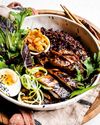
RICE BOWL Lunches
If you are working from home, or even enjoying your weekend, and lunchtime rolls around but you have no plans for lunch, then a rice bowl is an ideal saviour.

PLANT-BASED PIES
Pies are a piece of gastronomic brilliance: a filling with a case and lid you can eat is food genius. The first pies date back to Egyptian times and there is a recipe for chicken pie that was carved into stone more than 4000 years ago. For millennia, however, the pie casing was mostly used to cook the filling, but for around 500 years or more we have been eating the pie crust too.

20 FOOD CRAVING HACKS
Decipher the deeper causes of your cravings and discover tricks to curtail them.
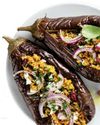
Eggplant (Solanum melongena L)
Eggplant is a wonderful option for vegans and vegetarians, extremely nutritious and highly versatile in the kitchen.
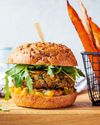
5 PANTRY SAVIOURS
Whether you're cooking a simple breakfast or something more exotic, here are five pantry food staples you should have on hand to cook plenty of delicious meals in the comfort of your own home.
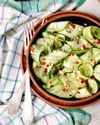
Cucumber (Cucumis sativus)
Cucumbers are delicious fresh but they also offer plenty more options in the kitchen.

Our Chefs
Meet the chefs who bring this issue's recipes to you: Lisa Guy, Georgia Harding, Lee Holmes, Sammy Jones, Raquel Neofit, Naomi Sherman and Ames Starr.